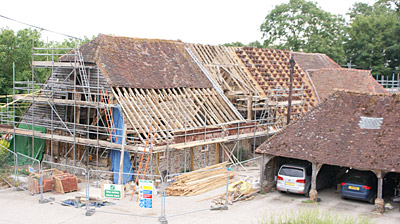The restoration of Tithe Barn
The holiday cottages look out on Grade II Sullington tithe barn.
This beautiful, ten-bay barn is evocative of past agricultural practices and community needs.
The structural details of the barn tell of the evolution of farming from the middle ages when the stalks were harvested whole and sheaves stacked to the rafters of the barn ready for threshing in the winter months.
In 18th/19th centuries ricks and threshing machines in the field led grain being delivered to the barn in sacks and in 20th century when grain from the combine harvester was delivered to pits in the floor of the tithe barn in vast quantities by tractor and trailer.
Restoration work on the barn
The main roof structure of the Tithe barn was built in 17th century, re-using the chunky timbers of an earlier medieval barn. Both the existing barn and its predecessor were impressive barns of their time and indicate that Sullington was a medieval settlement of some significance.
The barn was repaired in 2013 with financial assistance and historical advice from Natural England. Careful repair and sympathetic work by John Russell and his team at Timber structures caused a minimum of disturbance to the original fabric and maintained the romance, authenticity and atmosphere of the barn.

